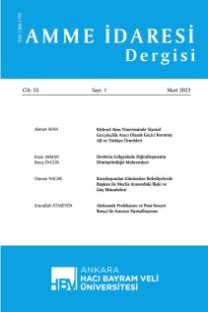Türkiye'de Cari Açık Sorunu ve Açığın Finansman Yapısı:1989-2015 Dönem Analizi
The Current Account Deficit Issues and its Financing Structure in Turkey: Analysis of the 1989-2015 Period
___
- Adıyaman, A.T. (2006), Dış Borçlarımız ve Ekonomik Etkileri, Sayıştay Dergisi, 62, 21-45.
- Aydoğuş, İ. & Öztürkler, H. (2006), Türkiye'de Cari İşlemler Açığı Sorununun Analizi, Gazi Kitabevi, Ankara.
- Bilginoğlu, M.A. & Aysu, A. (2008), Dış Borçların Ekonomik Büyüme Üzerindeki Etkisi: Türkiye Örneği, Erciyes Üniversitesi İktisadi ve İdari Bilimler Fakültesi Dergisi, 31, 1-23.
- Brown, R.L, Durbin, J. & Evans, J.M. (1975), Techniques for Testing the Constancy of Regression Relations over Time, Journal of the Royal Stastical Society, 37, 149-163.
- Çoban, O. & Çöğürcü, İ. (2011), Dış Borç Ekonomik Büyüme İlişkisi: Türkiye Örneği (1980-2009), Karamanoğlu Mehmetbey Üniversitesi Sosyal ve Ekonomik Araştırmalar Dergisi, 13(21), 133-149.
- Corden, W. M. (1994), Economic Policy, Exchange Rates, and the International System, Oxford: Oxford University Press.
- Dickey, D.A. & Fuller, W.A. (1979), Distribution of the Estimators for Autoregressive Time Series with a Unit Root, Journal of the American Statistical Association, 74(366), 427-431.
- Dickey, D.A. & Fuller, W.A. (1981), Likelihood Ratio Statistics for Autoregressive Time Series with a Unit Root, Econometrica, 49(4), 1057-1072.
- Dornbusch, R. & Fischer F. (1990), Macroeconomics, McGraw-Hill, International Editions.
- Edwards, S. (2001), Does the Current Account Matter?, NBER Working Paper Series, No: 8275, 38.
- Edwards, S. (2005), The End of Large Current Account Deficits, 1970-2002: Are These Lessons For The United States?, NBER Working Paper Series, No: 11669, September, 1-67.
- Erbaykal, E. (2007), Türkiye'de Ekonomik Büyüme ve Döviz Kuru Cari Açık Üzerinde Etkili Midir? Bir Nedensellik Analizi, ZKÜ Sosyal Bilimler Dergisi, 3 (6); 81-88.
- Erden, L. & Çağatay, O. (2011), Türkiye'de Cari İşlemler ve Sermaye Hesapları Arasındaki İlişki, Hacettepe Üniversitesi İktisadi ve İdari Bilimler Fakültesi Dergisi, 29(2), 49-67.
- Erkılıç, S. (2006), Türkiye'de Cari Açığın Belirleyicileri, Uzmanlık Yeterlilik Tezi, Türkiye Cumhuriyet Merkez Bankası İstatistik Genel Müdürlüğü, Ankara.
- Freund, C. & Warnock, F. (2005), Current Account Deficit in Industrial Countries: The Bigger They Are, The Harder They Fall?, NBER Working Paper Series, No: 11823, December, 1-39.
- Göçer, İ. (2013), Türkiye'de Cari Açığın Nedenleri, Finansman Kalitesi ve Sürdürülebilirliği: Ekonometrik Bir Analiz, Eskişehir Osmangazi Üniversitesi İİBF Dergisi, Nisan, Sayı: 8(1), 213-242.
- Granger, C. (1969), Investigating Casual Relation by Econometric Models and CrossSpectral Methods, Econometrica, 37, 424-38.
- Granger, C. (1988), Causality, Cointegration and Control, Journal of Economic Dynamics and Control, 12, 551-59.
- Gujarati, D.N. (2001), Temel Ekonometri, Ümit Şenesen, Gülay Günlük Şenesen, (Çev.) 2. Baskı, Literatür Yayıncılık, İstanbul.
- IMF (2014), World Economic Outlook Database, October. https://www.imf.org/external/pubs/ft/weo/2014/02/weodata/download.aspx (Erişim Tarihi, 12.04.2016)
- İpek, E. & Yaşar, B.K. (2008), Türkiye'de Ekonomik Büyüme ve Dış Borç İlişkisi, Uluslararası Sermaye Hareketleri ve Gelişmekte Olan Piyasalar Uluslararası Sempozyumu, Sunulan ve Bildiri Kitabında Basılan Bildiriler, Balıkesir.
- Johansen, S. (1988), Statistical Analysis of Cointegration Vectors, Journal of Economics Dynamic and Control, 12 (2-3), 231-254.
- Johansen, S. & Juselius, K. (1990), Maximum Likelihood Estimation and Inference on Cointegration with Application to the Demand of Money, Oxford Bulletin of Economics and Statistics, 52(2), 169-210.
- Karagöl, E.T. (2010), Geçmişten Günümüze Türkiye'de Dış Borçlar, SETA, Siyaset, Ekonomi ve Toplum Araştırmaları Vakfı.
- Obstfeld, M. & Rogoff, K. (1996), Foundations of International Macroeconomics, Cambridge: MIT Press.
- Pesaran, M.H., Shin, Y. & Smith, R.J. (2001), Bound Testing Approaches to the Analysis of Level Relationships, Journal of Applied Econometrics, 16, 289-326.
- Saçık, S.Y. & Alagöz, M. (2010), Türkiye'de Cari İşlemler Açığı Sorunu ve Borçlanma ile İlişkisi, Ekonomi Bilimler Dergisi, Cilt:2, Sayı:2, ss. 113-120.
- Sekmen, F. & Calışır, M. (2011), Is There a Trade-Off Between Current Account Deficitsand Economic Growth? The Case of Turkey, International Research Journal of Finance and Economics, 62, 166-172.
- Tarı, R. & Kumcu, F.S. (2005), Türkiye'de İstikrarsız Büyümenin Analizi (1983 - 2003
- Dönemi), Kocaeli Üniversitesi Sosyal Bilimler Enstitüsü Dergisi, 9(1), 156-179.
- Telatar, O.M. & Terzi, H. (2009), Türkiye'de Ekonomik Büyüme ve Cari İşlemler Dengesi İlişkisi, Atatürk Üniversitesi İktisadi ve İdari Bilimler Dergisi, 23(2), 119- 134.
- Türkiye Cumhuriyeti Kalkınma Bakanlığı, Ekonomik ve Sosyal Göstergeler, http://www.kalkinma.gov.tr/Pages/EkonomikSosyalGostergeler.aspx (Erişim Tarihi: 14.04.2016)
- Türkiye Cumhuriyet Merkez Bankası, Ödemeler Dengesi İstatistikleri'ne İlişkin Yöntemsel Açıklama, IMF Beşinci El Kitabına Göre, http://www.tcmb.gov.tr/odemedenge/odemet.pdf (Erişim Tarihi: 18.06.2014)
- Türkiye Cumhuriyet Merkez Bankası, Ödemeler Dengesi İstatistikleri'ne İlişkin Yöntemsel Açıklama, IMF Altıncı El Kitabına Göre, http://www.tcmb.gov.tr/wps/wcm/connect/TCMB+TR/TCMB+TR/Main+Menu/Istatisti kler/Odemeler+Dengesi+ve+Ilgili+Istatistikler/Odemeler+Dengesi+Istatistikleri/Yo ntemsel+Aciklama (Erişim Tarihi, 12.04.2016)
- Türkiye Cumhuriyet Merkez Bankası, Ödemeler Dengesi Raporu, 2013-IV, 12-28. Türkiye Cumhuriyet Merkez Bankası, Ödemeler Dengesi İstatistikleri http://www.tcmb.gov.tr (Erişim Tarihi: 10.02.2016)
- Türkiye İstatistik Kurumu, http://www.tuik.gov.tr (Erişim Tarihi: 11.03.2016)
- Uygur, E. (2004), Cari Açık Tartışmaları, İktisat, İşletme ve Finans, 19(222), 5-20.
- Yeldan, E. (2005), Türkiye Ekonomisi'nde Dış Açık Sorunu ve Yapısal Nedenleri, Çalışma ve Toplum Dergisi, 4 (7), 47-60.
- Yılmaz, Ö. & Akıncı, M. (2011), İktisadi Büyüme ile Cari İşlemler Bilançosu Arasındaki İlişki: Türkiye Örneği, Atatürk Üniversitesi Sosyal Bilimler Enstitüsü Dergisi, 15(2): 363-377.
- Yüksel, S. (2016), Türkiye'de Cari İşlemler Açığının Belirleyicileri: MARS Yöntemi ile Bir İnceleme, Bankacılar Dergisi, Sayı: 96, 102-121.
- ISSN: 1300-1795
- Yayın Aralığı: 4
- Başlangıç: 1968
- Yayıncı: -
Bürokratik Otoriteryan Rejimlerde Sosyal Politikanın Gelişimi ve Atfedilen Roller
Uluslararası Zirvelerin ve Bildirgelerin Dünya Bankası'nın Değişen Çevre Politikalarına Etkisi
Siyasetname Geleneğinde İktidarın Denetimi Sorunu: Nushatü's-Selâtîn Örneği
Pozitivizm ve Siyaset: Yöntembilimsel Bir Eleştiri
Türkiye'de Cari Açık Sorunu ve Açığın Finansman Yapısı:1989-2015 Dönem Analizi
Uluslararası Zirvelerin ve Bildirgelerin Dünya Bankası'nın Değişen Çevre Politikalarına Etkisi
Siyasetname Geleneğinde İktidarın Denetimi Sorunu: Nushatü's-Selâtîn Örneği
Kongre Bildirileri Üzerinden Yöntem Sorununu Anlamak: KAYFOR Örneği
